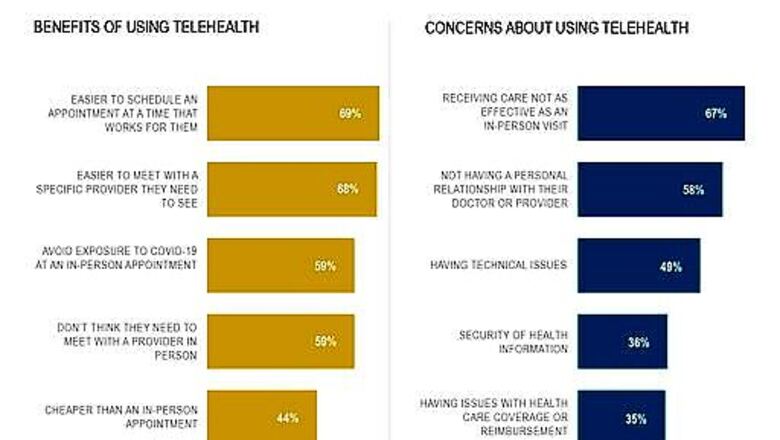
views
WASHINGTON: Most older Americans have had to use telehealth during the COVID-19 pandemic and many were comfortable with it, but a new poll finds persistent concerns about issues like technology, the quality of care and patient privacy.
Comfort levels with remote care can vary depending on factors like age, income level or race, according to the survey from The Associated Press-NORC Center for Public Affairs Research.
Doctors, hospitals and other care providers had to cancel visits and surgeries and abruptly switch to remote care as the pandemic unfolded in early 2020. Many patients followed their doctors online and have continued to get care that way as coronavirus cases ebbed and flowed in subsequent waves.
Telehealth involves patients and care providers connecting remotely through computers, tablets or phones. They often use video calls but also can trade emails or secure text messages. Sometimes both parties just talk on the phone without video.
Since the pandemic started, 62% of adults age 50 and older have used some form of telehealth, the AP-NORC poll found.
Patients most frequently used telehealth for consultations on medications, non-urgent health concerns, wellness checks or to continue with ongoing care to manage a chronic condition like diabetes.
The ease of finding an appointment or meeting a specific provider and the chance to get an immediate response were the most common reasons respondents opted for telehealth. Roughly a third said each was a major factor and another third called them minor factors.
A majority also cited avoiding COVID-19 exposure as a major or minor reason for seeking care through telehealth, with about a quarter calling it a major reason.
Rosa Bivens became a remote care convert during the pandemic partly because it helped her avoid the virus.
The 59-year-old Bivens also likes how telehealth allows her to stay connected to her doctor in Maryland while she’s on a temporary work assignment in Germany. Bivens is a military family life counselor, and she says her doctor back home understands the stress she faces in her job and how it affects her health.
That personal relationship is important to me, she said.
The poll found that those who received care through telehealth were generally comfortable with it. Roughly 6 in 10 said they were at least somewhat likely to seek such remote care after the pandemic ends.
But many concerns remain. Chief among them is worry about receiving care that is not as effective as an in-person visit. Roughly two-thirds of older adults said they were at least somewhat concerned with that.
Many also have some worry about not having a personal relationship with a doctor, running into information security or technical problems and a lack of privacy.
Judy Ostrom, for instance, didnt use remote care during the pandemic and has no plans to start.
You dont know who’s walking in and out of the room where the doctor is, the 60-year-old resident of La Pine, Oregon, said. I love my family, but sometimes you want your conversation with your doctor to be confidential.
Some concerns were more concentrated among adults age 65 and older. For example, those patients were more worried about not having a personal relationship with their doctor and not having the appropriate devices compared with people ages 50 to 64.
Debra Nanez, 69, of Tucson, Arizona, said she sticks to audio-only telephone calls with her doctors when she does telehealth. The retired nurse worries about the security of any health information shed have to enter into a website to do other forms of telehealth.
She also doesnt have a reliable way to do a video call.
Sometimes my phone acts funny; it will work and then suddenly the phone will turn off, she said. Thats why Ill just do it telephonically. I have no problems with it.
People making less than $50,000 are roughly three times as likely as those with higher incomes to feel that having a doctor provide the necessary devices for a telehealth visit would be very or extremely helpful. The poll also found that people with lower incomes are more likely to say it would be helpful if the doctor provided assistance in using the technology.
Nonwhite respondents are especially likely to see telehealth as a way to avoid COVID-19 exposure. But they are also more concerned than white respondents about the security of their health information, both for telehealth and in-person care.
The poll finds nonwhite older Americans are also especially concerned about meeting with a provider who does not understand their cultural preferences.
Education about telehealth and a growing familiarity with the practice can help alleviate some of the lingering concerns patients have, according to Mei Kwong, executive director for the Center for Connected Health Policy.
Kwongs California-based nonprofit researches and promotes the use of virtual technology in health care. She noted that once the pandemic started, the clinics and hospitals that were most successful in converting patients to remote care took the time to explain it and even do test runs before people made actual visits.
But Kwong, who was not connected to the AP-NORC poll, noted that this sort of education wasnt widespread.
Prior to the pandemic, telehealth was very niche, she said. Then when the pandemic hit, (patients) were just basically slapped in the face with it.
Nobody really explained what it was.
___
Murphy reported from Indianapolis.
___
The AP-NORC poll of 1,000 adults age 50 and older was conducted between November 12-15 with funding from The SCAN Foundation. It used a sample drawn from NORCs probability-based Foresight 50+ Panel of adults age 50 and older, which is designed to represent the U.S. population. The margin of sampling error for all respondents is plus or minus 4.3 percentage points.
Disclaimer: This post has been auto-published from an agency feed without any modifications to the text and has not been reviewed by an editor
Read all the Latest News here




















Comments
0 comment